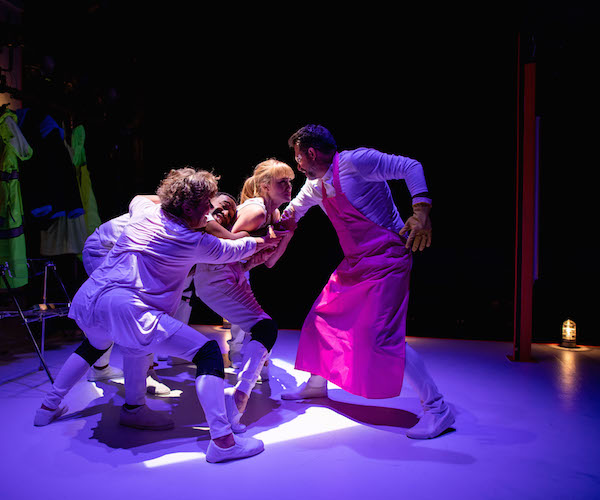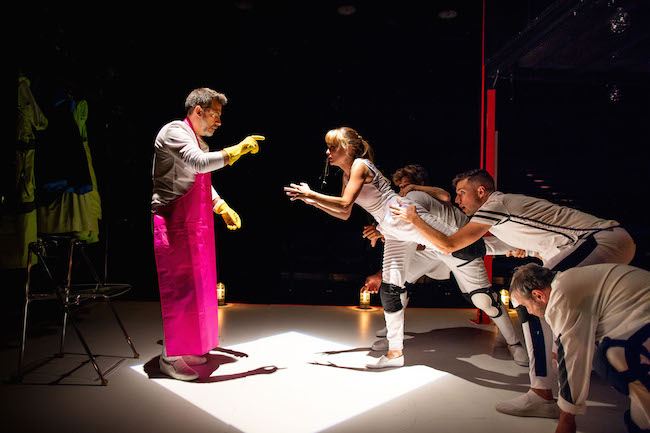Theater Review: “Frankenstein” — It’s Really Alive!
Frankenstein is a gripping amalgamation of the elemental and the technological.
Frankenstein by Nick Dear. Directed by David R. Gammons. Staged by the Nora Theatre Company/ Underground Railway Theater at the Central Square Theater, Cambridge, MA through November 4.

Debra Wise, Omar Robinson, Ashley Risteen, and John Kuntz in the Nora Theatre Company/ Underground Railway Theater production of “Frankenstein.” Photo: Nile Scott Studios.
By David Cruz
Victor Frankenstein stands atop a scaffold, taking furious notes as you enter the theater. Below him is a cage, covered in plastic sheeting, hiding the yet unanimated creature. The set is flanked by large lighting fixtures, covered in neon colored clothing. The doctor (John Kuntz) is dressed in simple white clothing, modern enough to fit with his white Vans, with just enough black to evoke the image of an imperial stormtrooper. The industrial aesthetic suggest the idea of a warehouse or a sterile lab room: one is reminded of facilities in nearby laboratories at Novartis and MIT. (This is a Catalyst Collaborative @ MIT production.)
The action begins when Victor climbs down the ladder into the laboratory, the “Modern Prometheus” coming down the mountain, bringing down his fire. The walls of the laboratory rise up, revealing the ‘monster’ —a mangle of human bodies, the other five cast members writhing as the creature is born. They threaten to swallow up the doctor, but he escapes, leaving this thing to explore the world on its own.
The creature doesn’t know how to read, speak, or even walk. Seen from the monster’s perspective, these scenes require challenging pantomime and motion work. The actors move in sync, their motions heightened and exaggerated. The physicality of their performance gestures toward dance much more than it does theater blocking. The creature stumbles about, trying to make sense of the world. All who encounter it are repulsed; the monster is forced to flee from town to town. Eventually, a blind man, Delacey (Remo Airaldi), takes the creature in, not seeing that it is misshapen. He teaches the monster to speak, to read — enough poetry to both question and understand its own existence. (This is a 19th century novel, after all.)
After this point, audiences may be less familiar with the story, though this fable is now celebrating its 200th anniversary. The creature uses Frankenstein’s journal to track him to Geneva. There it murders his young brother William (David Keohane) in order to catch Frankenstein’s attention. The creature demands a mate from its creator, a means to alleviate its enormous loneliness. Frankenstein agrees, leaving his fiancé Elizabeth (Ashley Risteen) and traveling to Scotland in order to fashion the monster’s mate. But during the process he becomes skeptical of creating the means of creating a race of creatures, leading to a showdown between the monster and its maker.
One by one, the characters/performers emerge from the monster, ripping themselves from the theatrical amalgam to become an atomized self. Each actor is given a chance to be the lead voice of the creature — as well as to embody another character. The most consistent feature of the “monster” is its innocence, its passionate spontaneity, whether it takes the contradictory forms of cruelty or kindness. The multiplicity of Nick Dear’s creature in Frankenstein places Victor’s work within an ironically communal and political context. Each actor/character is a part of the creature, which challenges us to see that Victor is doing more than refusing to take responsibility for nurturing his creation. He is turning his back on his duty to society.
The Nora Theatre Company cast is outstanding. Of all the actors playing the creature, Omar Robinson — who plays the lead voice in two scenes with the doctor — is an especially fierce standout. His creature exudes a righteousness and a sadism that is simultaneously sympathetic and frightening. The dialogue, at its best, has a poetic directness, suggesting a modern version of a Greek chorus or a passion play, generating complex emotional and intellectual resonances.

John Kuntz, Ashley Risteen, David Keohane, and Remo Airaldi in the Nora Theatre Company/Underground Railway Theater production of “Frankenstein.” Photo: Nile Scott Studios.
Director David R. Gammons’ background as a visual artist proves to be invaluable. The lighting shifts, brilliantly, from bright incandescence to cold fluorescence. Ominous, ambient music enhances the brooding setting. The result is that Gammons and the NTC’s superb design team have come up with a haunting vision of a world that combines the primal and the scientific. The 19th century context of his play has been placed into an alien, fantastical dimension, an imaginative space that makes the most of Dear’s intent to explore contemporary ideas, particularly about female sexuality. There’s considerable risk in this type of ‘experimental’ storytelling. The opening sequence, in particular, is somewhat confusing. But overall, this Frankenstein is a gripping amalgamation of the elemental and the technological.
David Cruz is a radio producer and civic technologist. He has been an associate producer at Human Media and Programming Director at WYBCX Yale Radio. He currently works for the Commonwealth of Massachusetts.
Tagged: David Cruz, David R. Gammons, Frankenstein, Nick Dear, Nora Theatre Company
